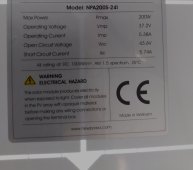MI Solar Guy
New Member
I wanna run this past everyone here who knows waaaay more then me.
Now my optimal tilt is 32.6⁰ for all seasons buuut, I'm thinking I can fanaggle this to compensate for over paneling in the summer and better tilt in the winter.
My thought is, in the summer we know solar works and works good. But if I position my panels more for the winter months and leave them there, over paneling would be perfect for summer and add more power in winter.
I came up with 40.1⁰ as the optimal tilt.
Obviously I won't over volt my SCC (150volts) but if I use the calculation I posted, I would go over on watts and amps.
I'm going to use 3s3p of the panels I posted a pic of.
Any advice is greatly appreciated.
Now my optimal tilt is 32.6⁰ for all seasons buuut, I'm thinking I can fanaggle this to compensate for over paneling in the summer and better tilt in the winter.
My thought is, in the summer we know solar works and works good. But if I position my panels more for the winter months and leave them there, over paneling would be perfect for summer and add more power in winter.
I came up with 40.1⁰ as the optimal tilt.
Obviously I won't over volt my SCC (150volts) but if I use the calculation I posted, I would go over on watts and amps.
I'm going to use 3s3p of the panels I posted a pic of.
Any advice is greatly appreciated.




